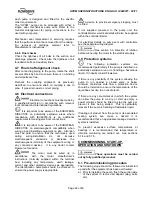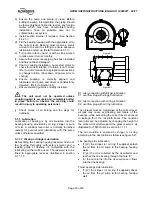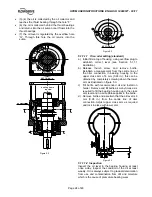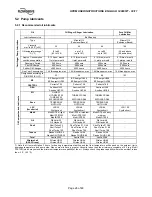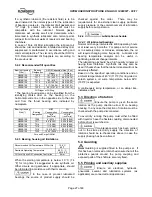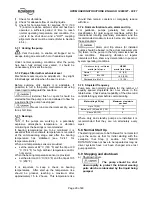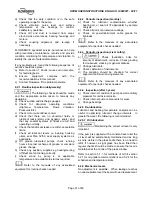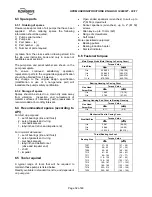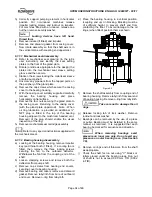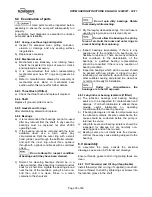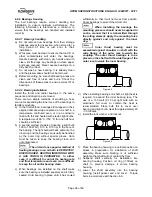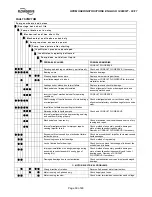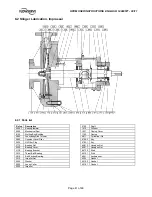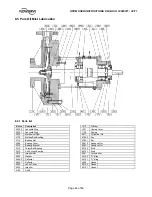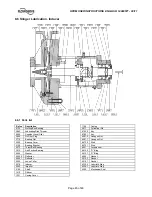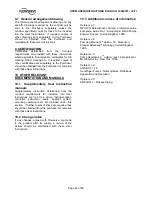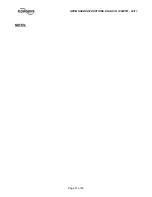
HPXM USER INSTRUCTIONS ENGLISH 14983571 - 03/11
Page 36 of 48
6.9.2 Bearings Housing
The ball bearings require correct handling and
installation to ensure optimum performance. The
following information is intended as a minimum to
ensure that the bearings are handled and installed
correctly.
6.9.2.1 Bearings handling
a) Do not remove new bearings from their storage
package except for inspection, when stored for a
long period of time or just prior to their
installation.
b) Work area must be clean to ensure that no dirt or
other contaminates will enter the bearings.
Handle bearings with clean, dry hands and with
clean, lint free rags. Lay bearings on clean paper
and keep covered. Never expose bearings on a
dirty bench or floor.
c) Do not wash a new bearing. It is already clean
and the preservative should not be removed.
d) Before mounting, be sure shaft bearing areas are
clean and free of nicks and burrs. Check the
dimensions of these areas to ensure correct fit of
bearings.
6.9.2.2 Bearing installation
Install the thrust and radial bearings in the same
sequence and direction as removed.
There are two simple methods of providing a heat
source for expanding the inner race of the bearings to
facilitate mounting.
a) In the first method, bearings still wrapped in their
original intimate wrap are placed on a shelf in a
temperature controlled oven, or in an enclosure
lined with foil
and heated with electric light bulbs.
A temperature of 66 °C (150 °F) for one half hour
should be sufficient.
b) A second method consists of locating a light bulb
100 to 150 Watt ( 0.13 to 0.15 hp) in the bore of
the bearing. The light bulb will heat, primarily, the
inner ring and the bearing can usually be handled
by the outer ring without special gloves. Care
must be taken to keep the bearing clean and
uncontaminated.
The old and once popular method of
heating bearings in an oil bath is DEFINITELY
DISCOURAGED. HEATING INNER RING WITH
A GAS TORCH IS PROHIBITED. In either
case, it is difficult to control the heating rate
and final temperature and even more difficult
to keep the oil and/or bearing clean.
c) When bearings are installed on the shaft make
sure the bearing is installed squarely and is firmly
seated. Hold bearing in place until it has cooled
sufficiently so that it will not move from position.
Cover bearings to protect them from dirt.
When installing the bearings the
mounting pressure should never be applied
in
such a manner that it is transmitted through
the rolling element. Apply the mounting force
directly against, and only against, the inner
ring.
Inner thrust bearing must be
assembled against shoulder on shaft with the
wide flange of the outer race towards the
coupling. The outer thrust bearings is to be
placed on the shaft with the wide flange of the
outer race towards the inner bearing
.
Figure 6.5
d) When installing bearings on shaft, a slight heat is
required to expand the inner bearing race. The
use of a 150 watt (0.15 hp) light bulb with an
aluminium foil cover to contain the heat is
recommended. Place bulb foil to cover over
bearing and light bulb. Heat for approximately 20
- 30 minutes.
e) Install the lock washer and locknut.
Figure 6.6
f) Place the bearing housing in a vertical position on
blocks in preparation for installation of shaft
assembly. Make sure blocking is of sufficient
height so that shaft will not contact the floor.
g) Suspend shaft vertically for installation into
bearing housing. Position oil ring (if fitted) on
shaft to prevent damage it enters bearing
housing.
h) Lower the shaft assembly into the bearing
housing. Install gasket and end cover. Torque
bolts in accordance with Section 6.6.

